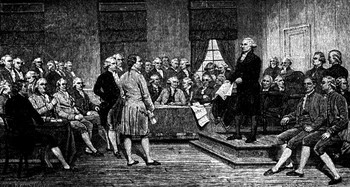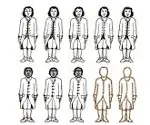The Three-Fifths Compromise
The North-South divide that eventually widened into the chasm that created the Civil War began early in the history of the country. All of the 13 Colonies began as large farm-based entities. It wasn't long, however, before the North became more and more focused on cities and big business and, eventually, industrialization. 
At first 12 of the 13 Colonies allowed slavery. (Georgia founder James Oglethorpe was opposed to it and wouldn't allow when he set up the Georgia colony.) Gradually, the economies of the Southern states depended more and more on slave labor to continue to thrive. In the wake of the authoritarian abuse that the Declaration of Independence charged England's King George III with committing, the 13 Colonies set up a deliberately decentralized government under the Articles of Confederation. One of the prime weaknesses of that governmental blueprint, in practice, was that all laws required the consent of all colonies. Naturally, all laws included laws of taxation, and the loose-framework government needed money to survive. The U.S. Government under the Articles of Confederation did collect some taxes and apportioned them according to land value, not population. The trusting government left it up to the individual states to quote their own land values, and so the practice of undervaluing a state's land value was not altogether uncommon. The Continental Congress debated the idea of apportioning taxation according to population but could not come to an agreement because of the thorny issue of whether and how to include enslaved people in the population count. The idea was prevalent at the time that slaves were worth less than non-slaves, and so the delegates to the Continental Congress debated how to include slaves in terms of a ratio, of non-slaves to slaves. Northerners suggested a ratio of 4-to-3, meaning that for every four slaves in a particular states, three would be counted in terms of a state's overall population. Southern state representatives favored a ratio of 2-to-1 or even 4-to-1. James Madison suggested a ratio of 5-to-3. No proposed ratio got unanimous approval, and so the idea was put aside. 
The Constitutional Convention returned to the idea and accepted Madison's proposed ratio, in the form of a new proposal put forward by James Wilson of Pennsylvania and Roger Sherman of Connecticut. Some Northern delegates objected to the counting of slaves at all because they had none of the rights normally associated with nominally taxpaying residents: voting, owning property, or even personal liberty. In the end, though, a majority of the delegates at the convention accepted the idea along with the others that made up the final draft of the Constitution and enough of the states ratified the document so that it became the law of the land. Article 1, Section 2, Clause 3 of the U.S. Constitution begins this way: "Representatives and direct Taxes shall be apportioned among the several States which may be included within this Union, according to their respective Numbers, which shall be determined by adding to the whole Number of free Persons, including those bound to Service for a Term of Years, and excluding Indians not taxed, three fifths of all other Persons." In effect, a slave was counted as three-fifths of a person. This is how the proposal came to be known as the Three-Fifths Compromise. 
Southern states were willing to support counting slaves for taxation purposes because they were also being counted for representation purposes. Because Southern states had many more slaves than did Northern states, the Three-Fifths Compromise benefited Southern states more than it did Northern states in terms of representation in the House of Representatives. For example, representatives of Southern states comprised 45 percent of the seats in the first Congress, which was elected in 1789 and took office in 1790; by contrast, only five states had a sizable three-fifths slave count. The numbers were these: Of the 105 total members of the House, Southern states had 47; if slaves had not been included in the population count, Southern states would have had only 33 of the 105. In 1812, the difference was even starker: 76 (instead of 59) of 143 Representatives were from Southern states. The tide turned when more Northern states joined the Union and states in the North gained more and more residents. Still, during the first few decades of the existence of the new country, Southern states enjoyed a stronger grip on Congress and the presidency than they otherwise would have. The Three-Fifths Compromise language is still in the Constitution but was rendered moot by the advent of the 13th Amendment and 14th Amendment. In fact, Section 2 of the 14th Amendment reads thus: "Representatives shall be apportioned among the several States according to their respective numbers, counting the whole number of persons in each State, excluding Indians not taxed." |
|
Social Studies for Kids
copyright 2002–2024
David White




